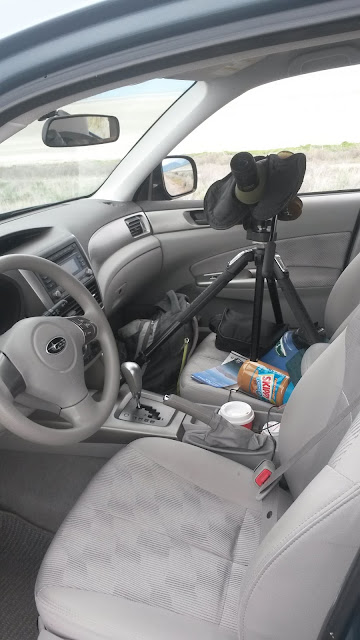10. Hooded Warbler –8/9/2016
Just a Hooded Warbler, you say? Well—I do love Hooded Warblers. This one was particularly special—I saw it
down the street from my house in my first week or so of living there. I heard
the metallic chink and tracked down a
handsome male. It inspired me to regularly bird my yard and neighborhood. http://ebird.org/ebird/view/checklist/S31042810
9. American Tree Sparrow—11/23/2016
 |
| Photo by Trish Gussler |
8. Pinyon
Jay—5/11/2016
“Have you ever seen a Pinyon Jay around here?” Joel asked as
we coursed down the highway that leads to the Such lair in the foothills above
Boulder. “Don’t think so,” I said. Moments later, a blue bird flew across the
road—followed by a battalion scores strong of Pinyon Jays. Joel claims that it
was a coincidence. http://ebird.org/ebird/view/checklist/S29577952
7. Williamson’s Sapsucker—5/7/2016
My long-lost friend Andrew guided me around Montana for a
couple days. We launched a campaign to the Bridger Mountains in search of this,
the smartest of the sapsuckers. We eventually found a male and watched it until
our attention was stolen by a pair of goshawks. I don’t see either of these
species frequently enough. http://ebird.org/ebird/view/checklist/S29478376
6. Hispaniolan Trogon—3/16/2016
Trogons are crowd-pleasers. This—one of Hispaniola’s
endemics—inhabits pine and cloud forest. My comrades and I undertook an epic
hike and finally—after multiple false alarms and alluring calls—spotted one. http://ebird.org/ebird/view/checklist/S28254913
5. Sharp-tailed Sandpiper—11/20/2016
 |
| Sandpiper success with Dad! |
A vagrant common enough in North America to be illustrated
in field guides but rare enough to never actually be seen. A wayfaring juvenile
was kind enough to coincide its visit to the Los Angeles River with my
pilgrimage home to California for Thanksgiving. I went to see it with my dad,
who shared and facilitated many of my formative birding experiences and with
whom I don’t bird with often enough anymore! We saw the bird despite a
ferocious downpour that forced us to retreat to the shelter of a bridge. http://ebird.org/ebird/view/checklist/S32646838
4. Gray-throated Chat—1/15/2016
A pretty bird of the tropical dry forests of Mexico, Belize,
and Guatamala, and one that I very much wanted to see on my Mexico trip for
reasons I can’t explain. While birding the nonpareil Calakmul ruins, my friend
Joel encountered a pair attending an ant swarm. http://ebird.org/ebird/view/checklist/S27003082
3. Red Phalarope—10/14/2016
 |
| Uncropped phone photo! |
A great rarity in Alabama. The sighting was all the more
notable by the fact that the bird was fearless, floating within five feet of
our astonished faces and lenses. https://ebird.org/ebird/view/checklist?subID=S32039996
2. Hispaniolan Woodpecker – 1/24/2016
I spent many hours this winter observing Hispaniolan
Woodpeckers and suffered greatly for it—lichen particulates lodged in the
eyeball, feet planted in hidden piles of cow excrement, arcs of bat guano
raining down upon my head, sore muscles from hunching in a burlap blind. http://ebird.org/ebird/view/checklist/S27099270
1. Keel-billed Toucan—1/11/2016
It was my first full day of birding in the Neotropics. The
end of the day was approaching; my friend Joel and I had had a long day of
being traumatized by Mexican driving and being overwhelmed by a dizzying array
of new tanagers, orioles, and flycatchers. We were standing beside a small pond
when we heard it coming. Whoosh whoosh
whoosh—the wingbeats of a large bird. A pair appeared overhead—my first
toucans! http://ebird.org/ebird/view/checklist/S27005037
Farewell, 2016.










































